Open Hardware/Modding: Raspberry Pi and Retro Projects
-
Emulate Any ISA Card With A Raspberry Pi And An FPGA
One of the reasons the IBM PC platform became the dominant standard for desktop PCs back in the mid-1980s was its open hardware design, based around what would later be called the ISA bus. Any manufacturer could design plug-in cards or even entire computers that were hardware and software compatible with the IBM PC. Although ISA has been obsolete for most purposes since the late 1990s, some ISA cards such as high-quality sound cards have become so popular among retrocomputing enthusiasts that they now fetch hundreds of dollars on eBay.
-
My Writing Laptop is 15 Years Old
One of the things that I have been thinking about lately is how I get value out of some of my older laptops. To a degree, nostalgia has been a motivator (who doesn't like tinkering around in obsolete versions of Windows?), but I actually want these things to do more for me than just tickle my early-aughts memory recall.
-
Meet your new two-factor authenticator: your Commodore 64
The TOTP display depends on the Time-of-Day clock in CIA #1. This is different from the Timer A jiffy clock accessible in BASIC as TI and TI$; the CIA TOD clock is a real clock that keeps time in BCD and uses either the 60Hz or 50Hz frequency from your wall mains. We use this clock because it is unaffected by interrupts. If the progress bar fails to advance, your CIA #1 is broken, and/or the 9V AC line from your power supply is defective, and/or the 2.7V Zener diode and/or glue chip (on breadbin 64s, a 74LS08 or similar, on 128s, a 74LS14) connected to the TOD pin of the CIAs have blown. If everything else with your system functions normally, then it's likely the latter two components since relatively few programs use the TOD clock but do use other CIA features. On a breadbox 64, check U27 and CR1. On a 128 or 128D(CR), check U16 and CR8; on the 128D(CR), CR8 is inconveniently under the power supply at the edge of the logic board, so you'll have to unscrew it from its standoff and the rear and side of the case to move it away. (I mention this because during testing it turned out my "daily driver" 128DCR has a faulty TOD clock. Fixing this will be a future blog entry. Fortunately both VICE and the SX-64 worked fine.)
-
Acorn RiscPC: Restoration Part 2
I decided at this point to plug in the motherboard, turn it on and see what happens. I have two SIMMs with this and the machine only needs one, the 4MB stick and the corroded 32MB stick. So, for starters I tried with the 4MB stick. This is what I got on the screen.
-
The unusual bootstrap drivers inside the 8086 microprocessor chip
The 8086 microprocessor is one of the most important chips ever created; it started the x86 architecture that still dominates desktop and server computing today. I've been reverse-engineering its circuitry by studying its silicon die. One of the most unusual circuits I found is a "bootstrap driver", a way to boost internal signals to improve performance.1

